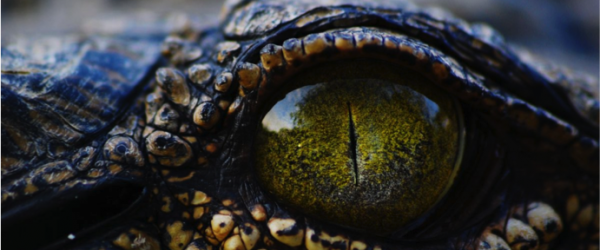According to a study in Australia on the 22nd of October, crocodiles have been seen to sleep with one eye remaining open [1]. This has led crocodiles to join a number of terrestrial, aquatic and avian species which perform this widespread and highly vital sleeping characteristic. Sleep plays an essential role in the health of a wide range of organisms, yet it also is the time many animals are at their most vulnerable to attack. To compensate for this, a wide range of animals including representatives of all three orders of aquatic mammals [2] (Cetaceans; whales and dolphins, Sea cows and Pinnipeds; seals) have developed the ability to perform unihemispheric sleep.
Unihemispheric slow-wave sleep (USWS), also known as asymmetric slow-wave sleep, is when the animal obtains the ability to sleep within one half of the brain, whilst the other remains alert. In order to perform this, the eye corresponding to the brain in deep sleep performs non-rapid eye movement sleep and is shut, whereas the other eye remains open. Studies show that this eye not only remains open but also is able to monitor the environment and any movements that occur in the vicinity [1].
Electroencephalography (EEG) is a procedure that records the electrical activity along the scalp. It works by documenting the fluctuations in voltage that occur due to the ionic current flows released by neurons situated in the brain. Slow wave sleep (SWS) is associated with deep sleep and a desynchronized stage of the brain, with most animals indicating high amplitude and low frequency EEG readings when performing this sleep type. Desynchronization of the brain requires excitation of the forebrain and occurs when the previously synchronized oscillating systems are switched to desynchronizing [3]. This change occurs due to external influences or feedback and is fundamental in medical research as strong synchronized neurons can impair brain function (seen for example in Parkinson’s disease). Bihemispheric slow wave sleep can occur in either of the two hemispheres, whereas rapid eye movement sleep (REM) can only occur simultaneously in both regions. During unihemispheric sleep now witnessed in crocodiles, only one hemisphere exhibits the deep sleep EEG. It is believed that neurotransmitters are involved in the regulation of USWS, and research with Northern fur seals (Callorhinus ursinus) has shown that acetylcholine neurotransmitter is linked to the hemispheric activation [4].
In a study by Rattenborg [5] migrating birds where shown to undergo USWS in order to sleep whilst simultaneously maintaining navigating ability during flight. This adaptation has allowed migratory birds to obtain the ability to not require frequent stops to rest that would therefore hinder migration.
With the knowledge that crocodiles are more closely related to birds than other reptiles, it seemed necessary to investigate whether these ancient reptiles would exhibit the same phenomenon. The experiments were performed in an aquarium lined with infrared cameras in order to study the specimens throughout the day and night. During the study led by John Lesku and his colleagues from La Trobe University Australia, it was shown that crocodiles frequently slept with both eyes closed. However, when another crocodile was introduced to the tank the crocodiles continuously performed unihemispheric sleep patterns, with one eye remaining open. It is important to note however that while crocodiles retained one eye open whilst sleeping, no EEG studies have been performed to actually demonstrate that crocodiles are sleeping with only one hemisphere of the brain. Nevertheless, this physical alteration in sleep can be suggested with confidence to be a vigilance function. The Lesku study only incorporated juvenile crocodiles as adult specimens would have been difficult to handle. Consequently, this function performed by the crocodiles of this stage in maturity gave them more security in remaining involved in the crèche formation (crèche: a protected area for the hatchlings that is created by the adult crocodile as a means of protection). These can be inhabited for many months post-hatching [6][7]. This has also frequently been witnessed with dolphins when one eye is trained to remain focused on the pod during a resting period [8].
In an interview with BBC news Lesku added; “They definitely monitored the human when they were in the room. But even after the human left the room, the animal still kept its open eye directed towards the location where the human had been – suggesting that they were keeping an eye out for potential threats”. [1]
This new discovery that crocodiles have the ability to sleep with one eye open and remain alert, proposes the possibility that this evolutionary branch of animals may also have the capacity to perform USWS. Interestingly, due to its contrasting lack of vigilance and apparent vulnerability, the results may also suggest that the manner in which humans sleep is in fact evolutionarily novel, due to its obvious vulnerability to possible threats.
References
[1] BBC News, (2015). Crocodiles sleep with one eye watching – BBC News. [online] Available at: http://www.bbc.co.uk/news/science-environment-34572433 [Acsessed 24 Oct. 2015.]
[2] Mukhametov, L. M., Supin, A. Y., Polyakova, I. G. (1997) Interhemispheric asymmetry of the electroencephalographic sleep patterns in dolphins. Brain Research 134 581-584
[3]McCarley, R., Sinton, C. (2008) Neurobiology of sleep and wakefulness. Scholarpedia 4 3133
[4] Lapierre, J. et al., (2007) Cortical Acetylcholine Release is Lateralised during asymmetrical slow-wave sleep in Northern fur seals. Journal of neuroscience 27 11999-12006
[5] Rattenborg, N. (2006) Do birds sleep in flight? Natur wissenschaftern 93 413-425
[6]Magnusson, W. (2080) Hatching and crèche formation by Crocodylus porosus. American Society of Ichthyologists and Herpetologists.
[7]McIlhenny, A. (1935) The alligator’s life history. Christopher Publishing House, Boston.
[8] Oleksenko, A. I., Mukhametov, L. M., Polyakova, I. G., Supin, A. Y (1991) Sleep deprivation in bottlenose dolphins. J. Sleep Res 1 40-44